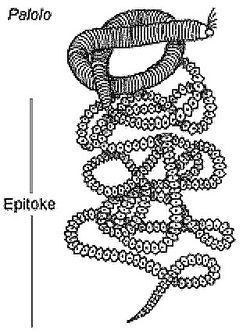Kingdom Animalia Order Eunicida Genus Palola Higher classification Palola Length 30 cm (Adult) | Phylum Annelida Family Eunicidae Scientific name Palola viridis Rank Species | |
 | ||
Similar Nereis, Palola, Oligochaeta, Pheretima, Alitta virens | ||
Palolo worm
The palolo worm or Samoan palolo worm (Palola viridis) is a Polychaeta species from the waters of the Pacific islands around Samoa.
Contents

Eating palolo worms
Life cycle

Reproduction involves mass spawning at night in spring or early summer (October - November in the Southern Hemisphere). The terminal parts of their bodies drop off and float over the surface of the water, releasing sperm and eggs. The mechanisms or triggers which induce spawning such that it occurs during nights of a waning moon, continuing for several nights, are not completely known.
Taxonomy
It is sometimes synonymous with Palola siciliensis.
Distribution
The palolo worm is found in various tropical regions, including in Indonesia, Vanuatu, Fiji, Samoa and American Samoa.
Cultural use
Indigenous populations in various parts of the Pacific – including Vanuatu and Samoa – use the reproductive portion of the palolo worm as a food source. During their short lived annual appearance in the last quarter of the moon in October and November, worms are enthusiastically gathered with a net, and are either eaten raw or cooked in several different manners.
In Indonesia, a traditional event called Bau Nyale are held between February and March in the Indonesian island called Pulau Lombok annually. The event focuses on catching these worms as bait or as a delicacy for the locals.
This event is so important to the inhabitants of the Torres and Banks Islands of Vanuatu that it is featured in their lunar calendar.
